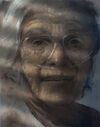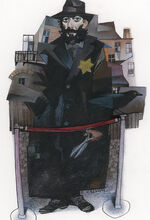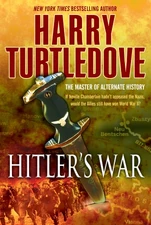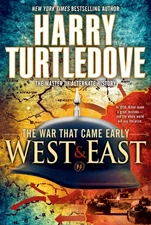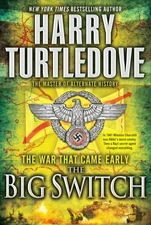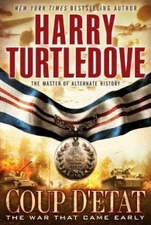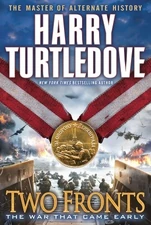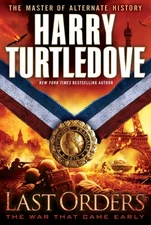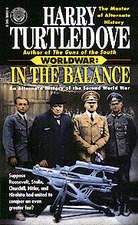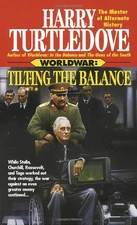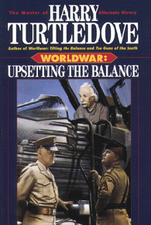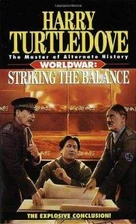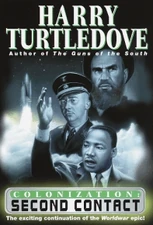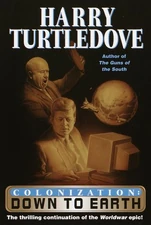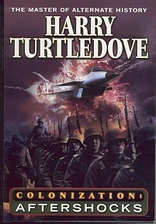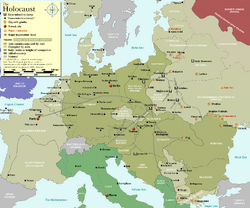
The Holocaust is the name applied to the genocide of minority groups of Europe and North Africa during World War II by Nazi Germany and its collaborators. Early elements of the Holocaust include the Kristallnacht pogrom of November 1938, and the T-4 Euthanasia Program, leading to the later use of killing squads and extermination camps in a massive and centrally organized effort to exterminate every possible member of the populations targeted by Adolf Hitler and the Nazis.
The Jews of Europe were the most numerous of the victims of the Holocaust in what the Nazis called the "Final Solution of the Jewish Question" (die Endlösung der Judenfrage) or "the cleaning" (die Reinigung). It is commonly said that around six million Jews were murdered in the Holocaust, though estimates by historians using, among other sources, records from the Nazi regime itself, range from five million to seven million.
Millions of other minorities also perished in the Holocaust in addition to this figure. About 220,000 Sinti and Roma were murdered in the Holocaust (some estimates are as high as 800,000), between a quarter to a half of the European population. Other groups deemed "racially inferior" or "undesirable": Poles (6 million killed, of whom 3 million were Catholic/Christian, and the rest Jewish), Serbs (estimates vary between 500,000 and 1.2 million killed, mostly by Croat Ustaše), Soviet military prisoners of war and civilians in occupied territories including Russians and other East Slavs, the mentally or physically disabled, homosexuals, Black people, Jehovah's Witnesses, Atheists, Communists and political dissidents, trade unionists, Freemasons, Eastern Christians, and Catholic and Protestant clergy, were also persecuted and killed.
Some scholars do not include the Nazi persecution of all of these groups in the definition of the Holocaust, rather limiting the Holocaust to the genocide of the Jews. However, taking into account all minority groups, the total death toll rises considerably, estimates generally place the total number of Holocaust victims at 9 to 11 million, though some estimates have been as high as 26 million.
Another group whose deaths are related to the Holocaust but not always counted in the totals is the thousands who committed suicide rather than face what they feared would be untold suffering ending in death. In 2006, the European Union financed a project to research these victims; despite religious prohibitions against suicide, it is estimated that in Berlin alone, 1600 Jews killed themselves between 1938 and 1945.
The term "Holocaust," from an Ancient Greek word for burning (with religious connotations), came to be used in medieval England as a synonym for large massacres. Printed materials began using the term to apply to the historical Nazi brutalities only in the 1960s, and was popularized by an American television drama first aired in 1978.
Literary comment
As most Harry Turtledove works involving the Holocaust have a POD before the 1960s, the characters do not refer to the genocide by that name, but instead refer to the extermination of the Jews or a similar description. The term Holocaust is used here for convenience.
Holocaust in "The Eighth-Grade History Class Visits the Hebrew Home for the Aging"
In 2013, Anne Berkowitz lectured to students from Junipero Middle School on how she survived the Holocaust.
Holocaust in In the Presence of Mine Enemies
With the Greater German Reich emerging victorious from World War II, the eradication of the Jews in Europe and North Africa went unopposed, reaching a state of "completion" within a few decades. This was spread to North America after Germany and Japan defeated the United States during the Third World War.
Nonetheless, Jews had survived in the heart of Germany, living in plain sight in the guise of Aryans, filling every part of Germany society, always aware of how precarious their existence was.
While the reforms of Führer Heinz Buckliger gave the surviving Jews of Berlin hope, it was a muted hope, as Buckliger did not publicly entertain the idea that persecution of the Jews had been wrong.
Holocaust in "In This Season"
In December 1939, Emes the Golem showed Berel Friedman a supernatural vision of the terrible fate which was to befall the Polish Jews in the coming years.
Holocaust in "The Last Article"
Having emerged victorious from World War II, Nazi Germany embarked on a programme of mass extermination of the European Jews. By 1947, the refugee Simon Wiesenthal was able to escape from Poland to India and informed Mohandas Gandhi and Jawaharlal Nehru of the situation in Europe. Gandhi did not believe Wiesenthal's claims as he was convinced that such actions would lead to a country's ruination. Nehru suspected otherwise and challenged Gandhi to find one Jewish soldier among the German occupation force. Gandhi noted that the British had had little use for Jews either. While Nehru agreed with this assessment, he pointed out that the British would never have banned Jews from serving in their military as the Germans had done.
Holocaust in The Man With the Iron Heart
Most members of the Allies occupying Germany after World War II were appalled by the mass murder of Jews under Nazi rule. American soldiers in particular grew very weary of protests from German civilians that they knew nothing of these actions. For many, the Nazis' crimes justified the continued occupation of Germany, even in the face of the successes of the German Freedom Front.
However, for those who wished to end the occupation, the crimes against the Jews were insufficient justification to maintain the occupation. Indeed, some occupation-opponents in the United States saw the occupation as pandering to the Jews, although this idea was not prevalent.
Holocaust in "Shtetl Days"
After Nazi Germany emerged victorious from the War of Retribution, the Grossdeutsches Reich oversaw the extermination of the Jews everywhere. While doing so, the Nazis made meticulous records of the people they exterminated. Thus, in the 21st Century, the Reich permitted the re-creation of shtetls, populated by Aryan actors playing the parts of Jews. These re-created shtetls became tourist attractions.
In the shtetl of Wawolnice, the actors played various roles common in a late 19th Century Jewish community. They spoke in Yiddish and Hebrew and scrupulously observed the tenets of Judaism. They were even subject to mock "pogroms", wherein certain parts of the town were burned, and condemned German convicts were allowed to be murdered.
However, the actors became so immersed in their re-creations that within time, they came to identify with their characters more than with their German identities. In this way, the Jews were quietly reborn.
Holocaust in The War That Came Early
After the Nazi armies invaded the territory of the Soviet Union, rumors started of large-scale massacres of Jews in these territories, but - as there were no independent observers - there was no clear information of the number of victims, and whether such massacres were the random acts of various soldiers or a systematic policy by the Nazi government. In 1944, when the Soviets regained rule over these territories, it was not yet clear whether or not details of the massacres of Soviet Jews by the Nazis would be investigated and published. Obviously, like Soviet policy on other issues, this would depend on whether or not Stalin would consider such investigation and publication of information to be useful.
Other Jews were less harshly treated by the Nazis. Germany valued its alliance with Poland enough to strictly order German soldiers to avoid molesting Polish Jews. In Germany itself, Jews suffered various forms of harassment, discrimination and persecution, but this did not get to the point of killing, and most German Jews survived the period of Nazi rule and the war.
At some times during the war, members of the Jewish Goldman Family in Münster uneasily reflected that the Nazis had "only so far only come down on them with one foot", though they did not like to dwell on how much worse their condition might become.
Holocaust in Worldwar
When the Race's Conquest Fleet invaded in 1942, at the height of World War II, Nazi Germany's extermination of the Jews had just began. The Race was appalled when they discovered the extent of the intended genocide. While the Race were heavily imperialistic in nature, however, they nonetheless had a difficult time grasping organised atrocity. The Jews under German control saw the Race as their only chance for survival, and so sided with the Race militarily and politically.
After the Peace of Cairo established German sovereignty, the Nazis stepped up their "Final Solution" within the borders of their empire. Despite the protests of the Race, Germany was able to eradicate the Jews within its borders. However, the Jews of the North America and in the Race's territory were able to thrive in relative safety. In particular, the Jews of Poland - about three millions, the second largest Jewish community in the world - mostly survived a very imminent death which the Nazis planned for them, and had many reasons to be glad that the Peace of Cairo awarded Poland to continued rule by the Race.
See also
- Population Reduction, a fictional genocide of Confederate Blacks in the Southern Victory series that is patterned on the historical Holocaust.
| |||||||||||||
| ||||||||||||||||
| ||||||||
| ||||||||||||||
| |||||||||||||||||
| ||||||||||
| ||||||||||||||||||||||
| |||||||||||||||||||||||||
